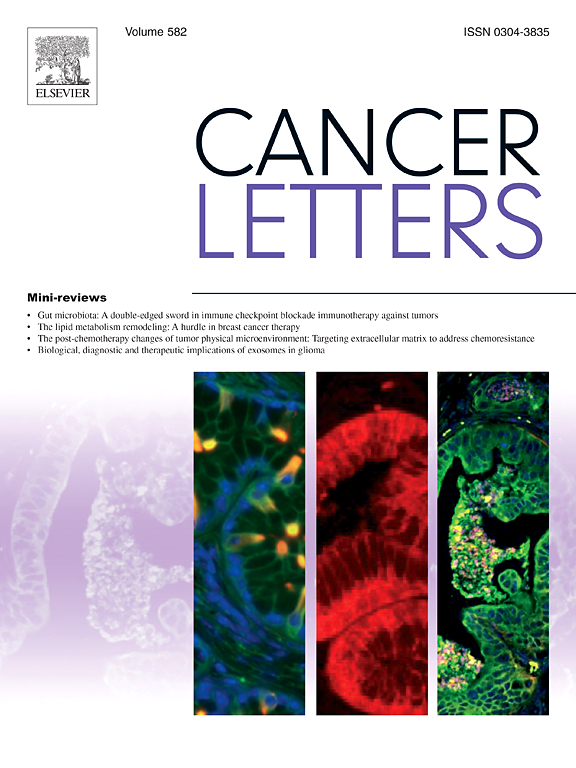WZ4003通过抑制ark5介导的自噬使肝细胞癌对OSI-027增敏
IF 10.1
1区 医学
Q1 ONCOLOGY
引用次数: 0
摘要
哺乳动物靶向雷帕霉素激酶抑制剂(mTOR-KIs)代表了一种新的有希望的癌症治疗选择。OSI-027是一种典型的mTOR-KI,在临床前模型中已被证实具有抑制肝细胞癌(HCC)增殖的作用。然而,mTOR-KIs对HCC的治疗反应有限,潜在的机制仍然是谜。本研究旨在揭示NUAK抑制剂WZ4003与OSI-027在HCC中的相互作用。研究发现,用OSI-027治疗可导致ARK5(也称为NUAK1)的上调,而ARK5敲低和WZ4003均可使HCC细胞对OSI-027敏感。有趣的是,ARK5的下调取消了WZ4003和OSI-027联合抗hcc的协同作用。此外,OSI-027触发自噬,WZ4003可以逆转这一效应。此外,WZ4003被发现以ARK5依赖的方式调节自噬,unc-51样自噬激活激酶1 (ULK1)的Ser757位点磷酸化是ARK5的下游效应物。值得注意的是,氯喹处理和ULK1-S757E转染都消除了OSI-027/WZ4003的协同作用。我们还证实了OSI-027和WZ4003在肝癌异种移植模型中的协同作用模式。此外,在HCC标本中观察到ARK5表达升高,并且与不利的无复发生存(RFS)独立相关。我们的研究结果提出了一种新的策略来提高HCC对OSI-027的敏感性,进一步强调了ARK5和自噬作为癌症治疗靶点的重要性。本文章由计算机程序翻译,如有差异,请以英文原文为准。
WZ4003 sensitizes hepatocellular carcinoma to OSI-027 by inhibiting ARK5-mediated autophagy
Mammalian target of rapamycin kinase inhibitors (mTOR-KIs) represent a novel promising treatment option for cancer therapy. OSI-027, a typical mTOR-KI, has been confirmed to suppress the proliferation of hepatocellular carcinoma (HCC) in preclinical models. However, mTOR-KIs confer limited therapeutic response against HCC, and the underlying mechanism remains enigmatic. The present study aimed to reveal the interaction between NUAK inhibitor WZ4003 and OSI-027 in HCC. Treatment with OSI-027 was found to result in up-regulation of ARK5 (also known as NUAK1), whereas both ARK5 knockdown and WZ4003 sensitized HCC cells to OSI-027. Intriguingly, knockdown of ARK5 abrogated the synergistic anti-HCC effect observed with the combination of WZ4003 and OSI-027. Additionally, OSI-027 triggered autophagy, an effect that could be reversed by WZ4003. Furthermore, WZ4003 was found to regulate autophagy in an ARK5-dependent manner, and phosphorylation of unc-51 like autophagy activating kinase 1 (ULK1) at Ser757 served as a downstream effector of ARK5. Notably, both chloroquine treatment and ULK1-S757E transfection abolished the OSI-027/WZ4003 synergy. We also confirmed a synergism pattern between OSI-027 and WZ4003 in an HCC xenograft model. Moreover, elevated ARK5 expression was observed in HCC specimens and was independently associated with an unfavorable recurrence-free survival (RFS). Our findings propose a novel strategy for augmenting sensitivity to OSI-027 in HCC, further underscoring the significance of ARK5 and autophagy as cancer therapeutic targets.
求助全文
通过发布文献求助,成功后即可免费获取论文全文。
去求助
来源期刊

Cancer letters
医学-肿瘤学
CiteScore
17.70
自引率
2.10%
发文量
427
审稿时长
15 days
期刊介绍:
Cancer Letters is a reputable international journal that serves as a platform for significant and original contributions in cancer research. The journal welcomes both full-length articles and Mini Reviews in the wide-ranging field of basic and translational oncology. Furthermore, it frequently presents Special Issues that shed light on current and topical areas in cancer research.
Cancer Letters is highly interested in various fundamental aspects that can cater to a diverse readership. These areas include the molecular genetics and cell biology of cancer, radiation biology, molecular pathology, hormones and cancer, viral oncology, metastasis, and chemoprevention. The journal actively focuses on experimental therapeutics, particularly the advancement of targeted therapies for personalized cancer medicine, such as metronomic chemotherapy.
By publishing groundbreaking research and promoting advancements in cancer treatments, Cancer Letters aims to actively contribute to the fight against cancer and the improvement of patient outcomes.
 求助内容:
求助内容: 应助结果提醒方式:
应助结果提醒方式:


